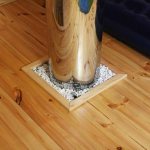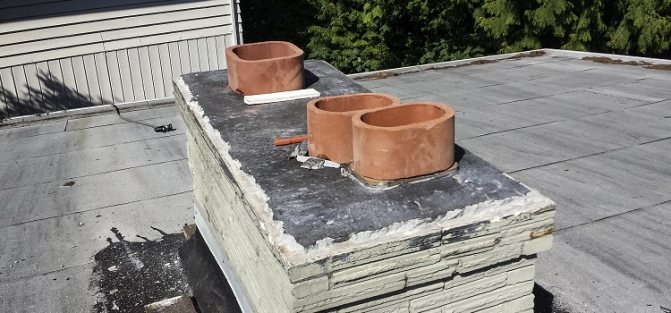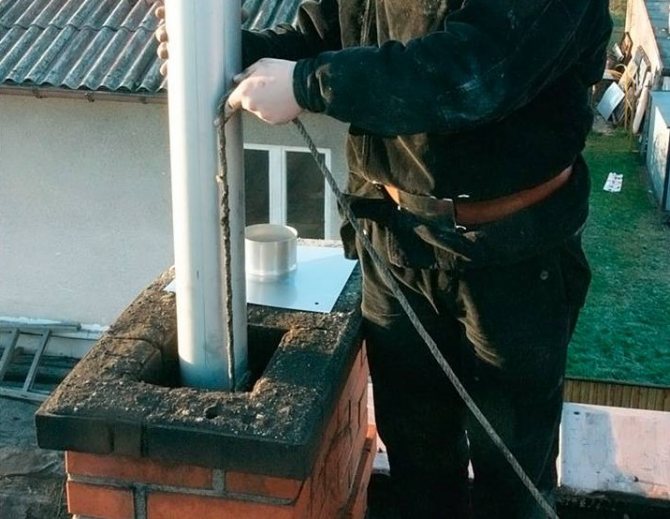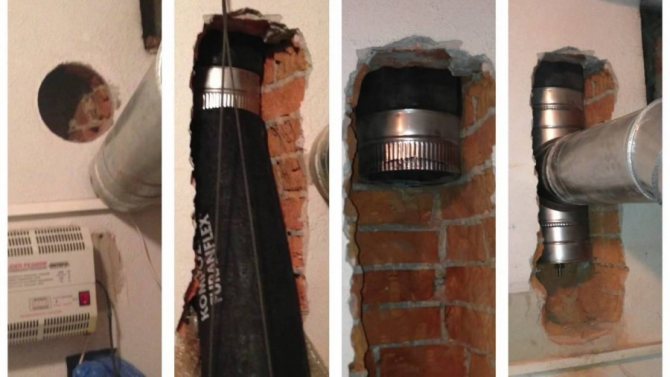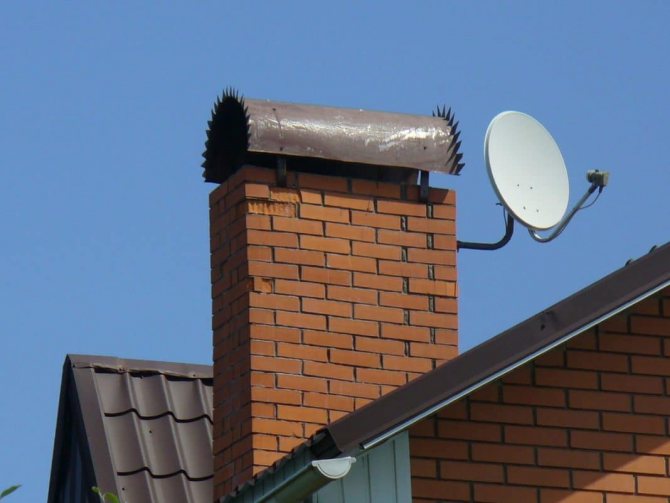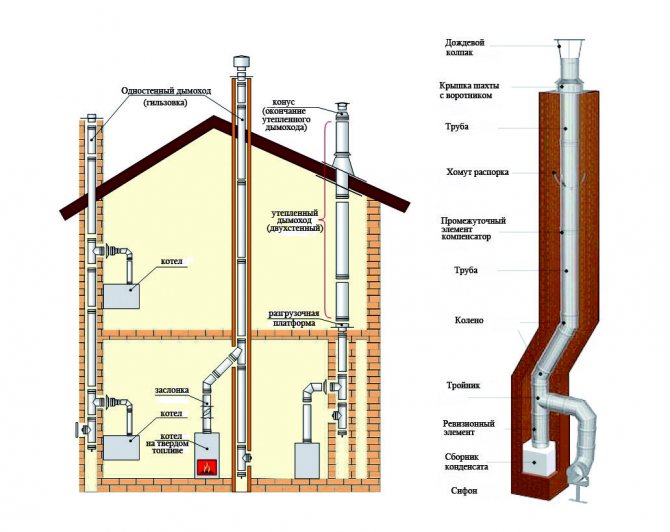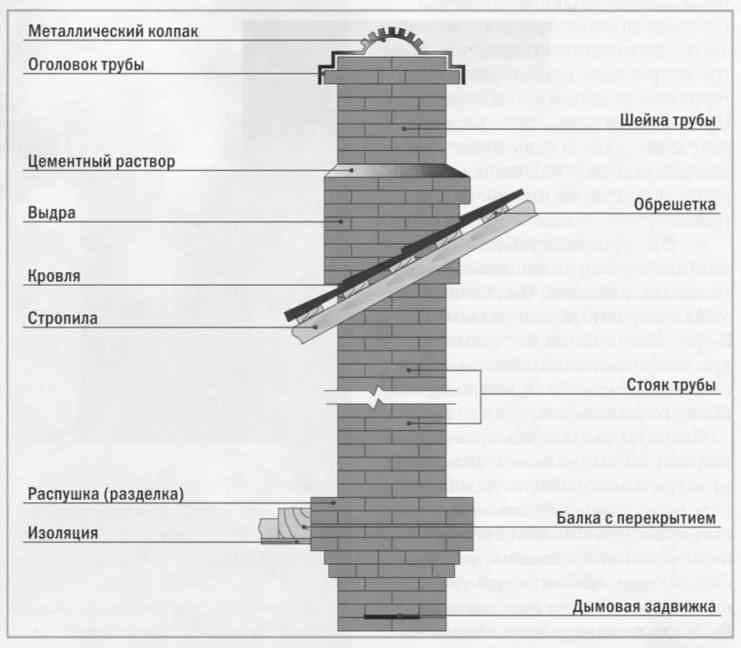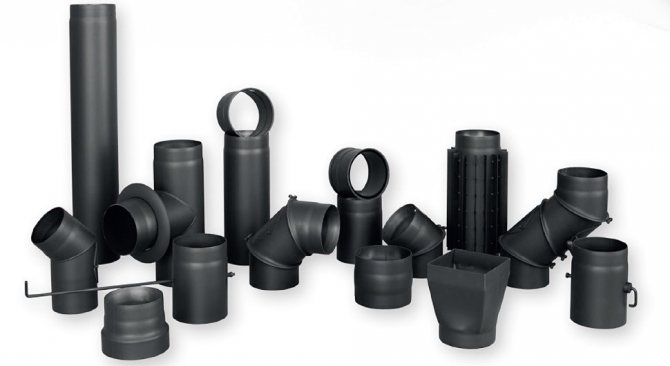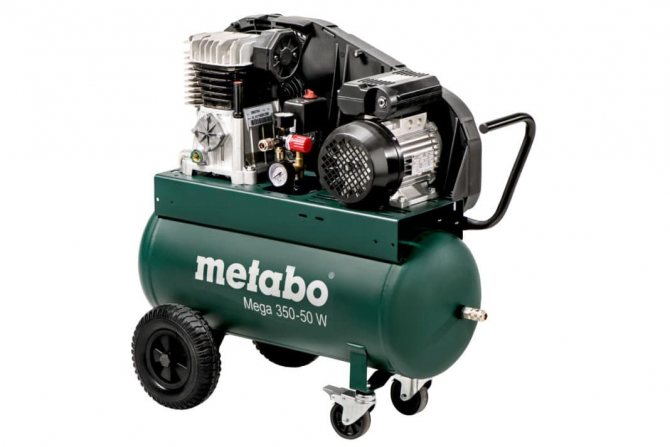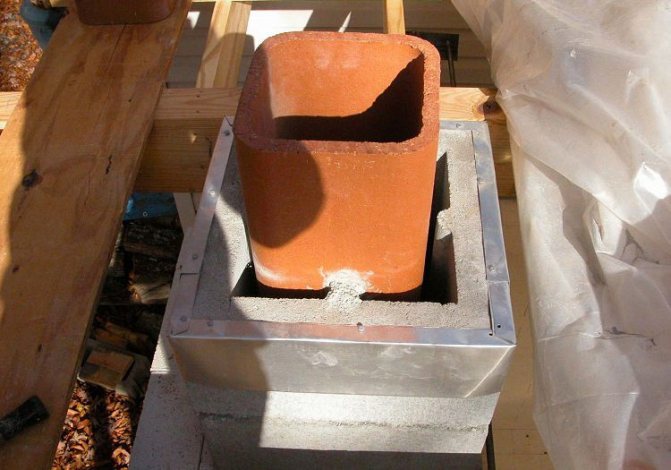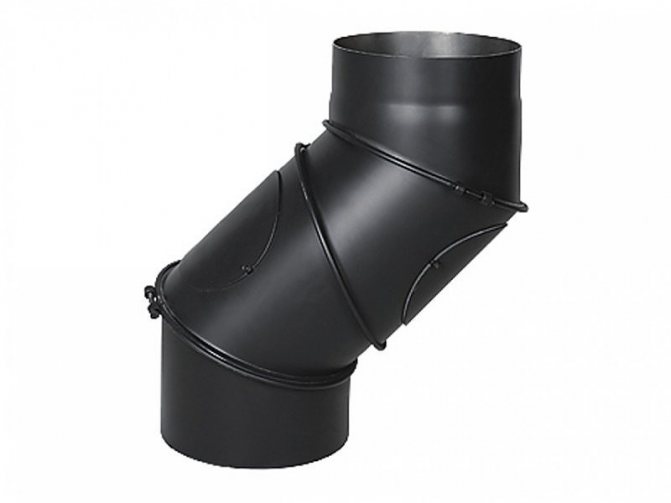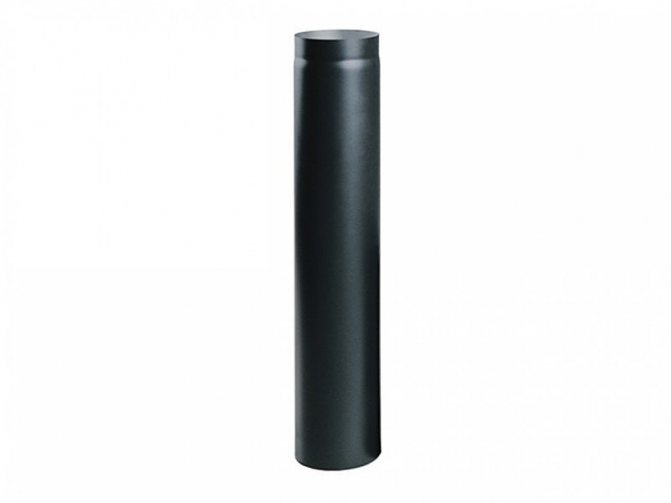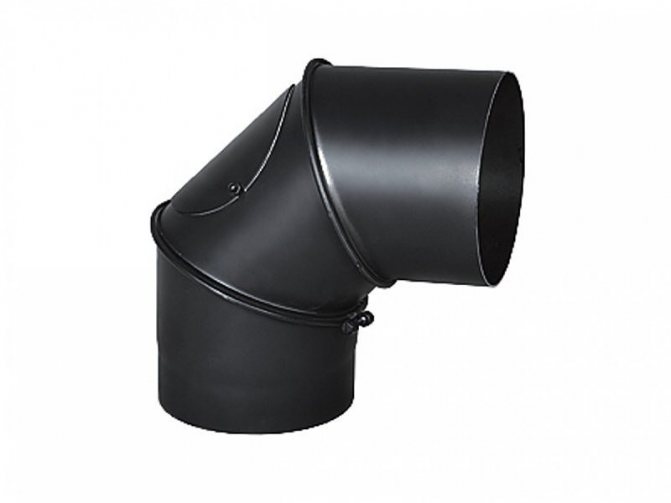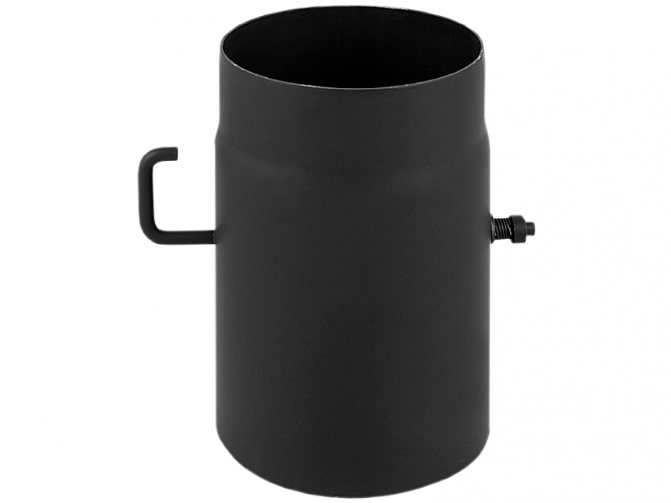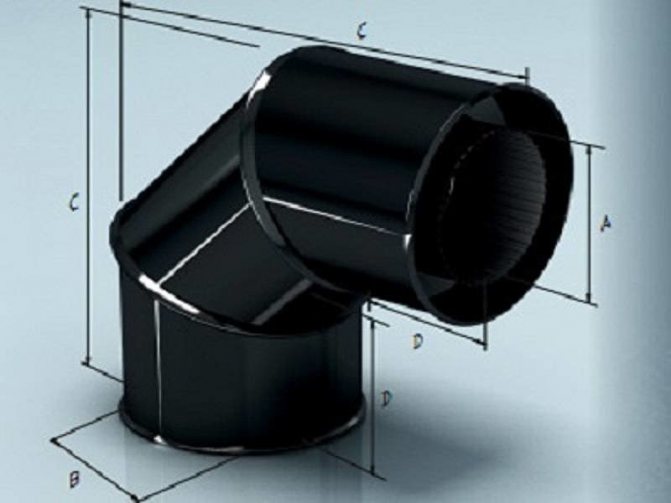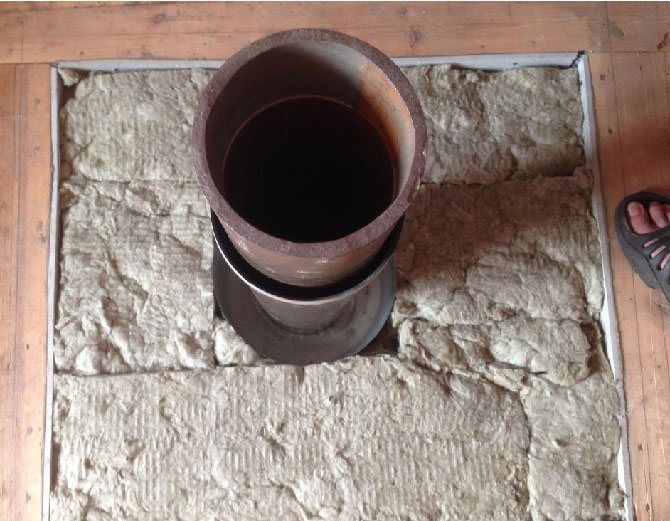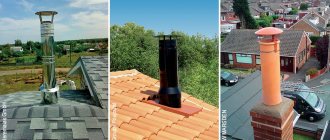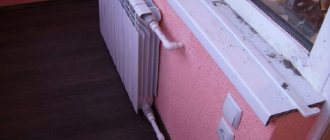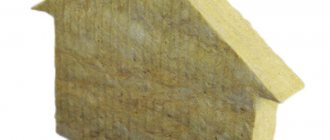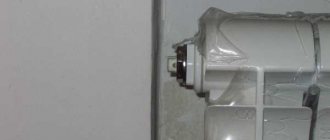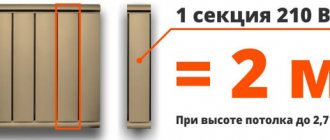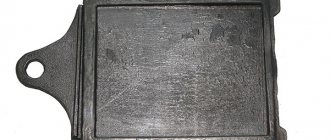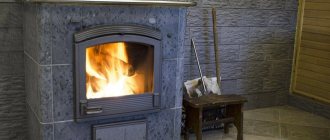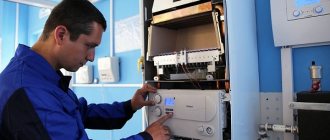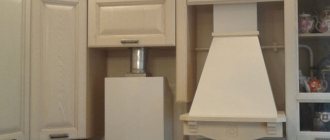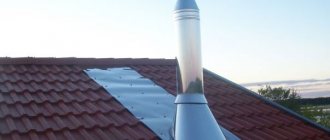Features and design of the chimney
The design of a brick chimney coming from a fireplace, stove, solid fuel and gas boiler is a shaft that forms a straight channel or with turns. The upper part of the structure is displayed above the roof, and a protective cap is put on from above.
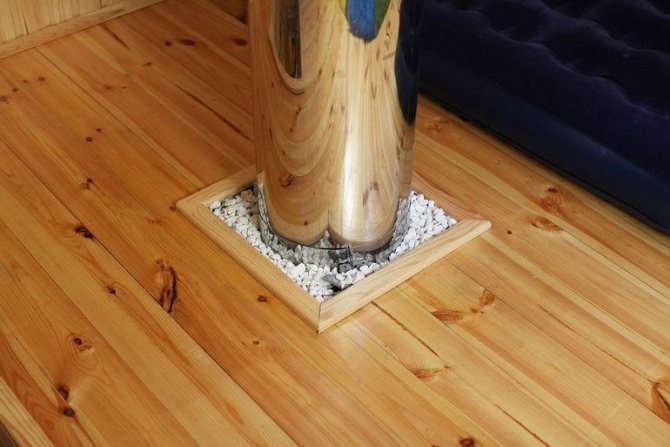
Principle of operation
When the boiler is on, the temperature at the bottom of the duct is higher than at the outlet. Due to the differential, a pressure difference is formed. The higher the number, the better the traction. The combustion products are freely discharged to the street, and oxygen enters the furnace to support combustion.
Materials and tools
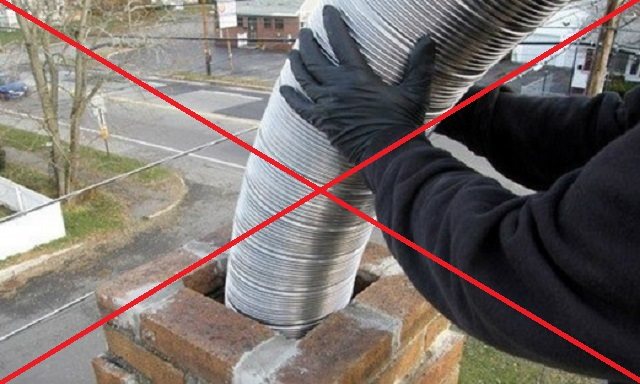

The chimney sleeve is the installation of a stainless steel pipe inside the exhaust duct. Its smooth surface will heat up quickly, which reduces condensation and soot escaping along with the smoke. The liner must be round or oval in stainless steel: when using solid fuel - AISI 321 or 409, the thickness of the liner is 0.8-1 mm, in the case of gas heating - AISI 304, the thickness is not less than 0.5 mm. The use of flexible stainless steel tubing is not recommended as soot and condensation will accumulate on the corrugated inner surface.
Exhaust duct requirements
Good traction is maintained by the tightness of the structure, as well as by the condition of low accumulation of soot and the formation of condensation. These parameters are the basic requirement for all chimneys. It is important to correctly calculate the cross-section so that there is no smoke inside the room.
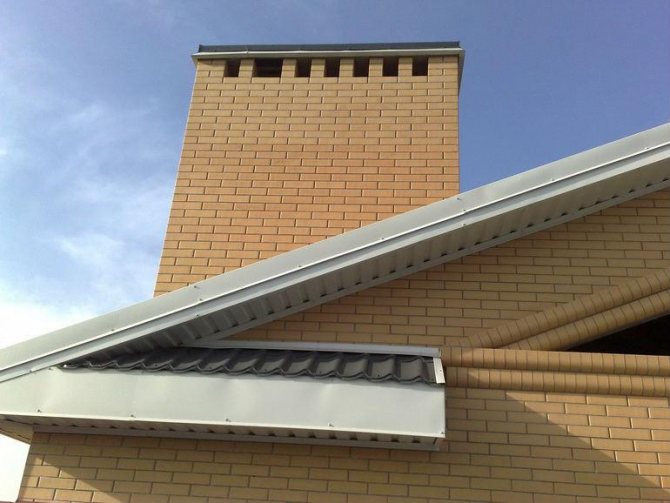

Key casing errors
The main mistakes are:
- Partial sleeve casing (not along the full length of the shaft).
- Using a knee instead of a special support.
- Crumpled pipe edges (if we are talking about stainless steel) during transportation, connection (segments with each other) or lowering into the mine.
- Jerks of the cable when lowering the sleeve.
- Narrowing of the diameter.
- Too sharp turns (if we are talking about a polymer liner).
- Use of bulk insulation (between the sleeve and the brick shaft).
- Absence of a U-shaped water seal - if the condensate is discharged directly through a hose to the sewer.
Please note: every mistake is serious enough. If they are allowed, then you can complicate your task in the future (if you need to replace the liner), or worsen the operation of the boiler.
What is a spark arrester, why is it needed on a chimney, and how to make it?
How to clean the chimney from soot with potato peelings?
Similar posts
The essence of the sleeve and its advantages
Before you rush to reconstruct a chimney, you need to figure out what a sleeve is, and also find out the advantages of the process.
Most chimneys have a rectangular duct section. For masonry, ordinary red or decorative bricks are used. Over time, large build-ups of soot appear inside the channels, efficiency decreases, and traction completely disappears. The problem lies precisely in the shape of the section, as well as the rough surface of the brick.
In round and oval canals, the inner walls are smooth. Soot does not cling to the walls.
In order not to build a new chimney, they came up with a sleeve. The procedure involves inserting the pipe inside the channel without destroying the brickwork. A stainless steel sleeve is considered the best option, but ceramics, asbestos or polymer can be used.
Benefits of the chimney duct sleeve:
- traction is enhanced due to the smooth surface of the liner;
- heat loss decreases, efficiency increases;
- no turbulence occurs inside the circular channel;
- the durability of the channels increases due to the resistance of the liner to condensation;
- the tightness of the chimney is improved.
The insert from the sleeve forms a new channel for the removal of combustion products, and the brickwork acts as a casing.
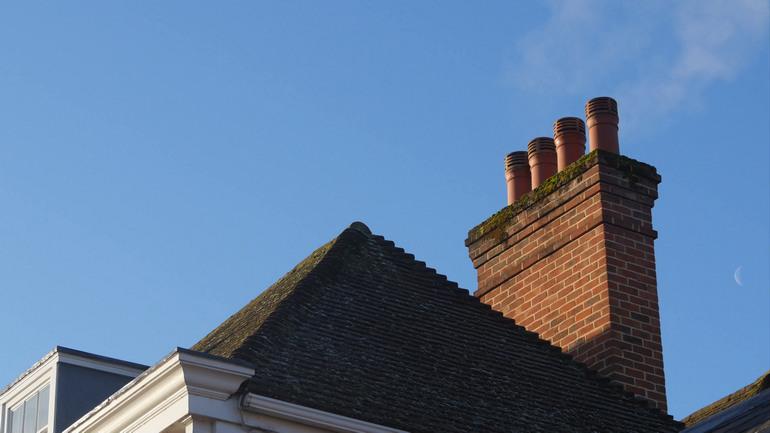

What is chimney sleeve?
The accumulation of soot on the walls of the chimney and the formation of condensate are the main reasons for the decrease in draft in the chimney. To improve the operation of the heating equipment, you can shift a new shaft or restore functionality using a sleeve. The construction of a new brick chimney requires significant finances and time, therefore, most often the old chimney is reconstructed using the liner method.
Chimney sleeve is the installation of a new line inside the channel without destroying the brickwork. The formation of the insert for the removal of combustion products provides a lot of positive points:
- the smooth inner surface of the liner leads to increased traction, the risk of clogging with soot is reduced to a minimum;
- the degree of tightness of the line increases;
- the functional characteristics of the chimney system are improved due to the resistance of the sleeve to condensate.
The sleeve has a positive effect on the efficiency of the heat generator and the terms of the high-quality service of the chimney.
Is there a need for a sleeve?
It is better to install the sleeve during the construction phase of the building. The insert is bricked up as the mine is laid out of bricks. If you did not initially do this, over time you will have to return to the process. The shelling of a completed house is more difficult. We will have to partially destroy the masonry, break the decorative cladding and restore everything again.
The urgent need to sleeve brick chimneys is caused by the following reasons:
- initially, the combustion products removal system was designed and built with errors;
- constant use of a fireplace or stove connected to a brick chimney is assumed;
- long canal length;
- if the mine needs to be sealed according to the project, but this was not done;
- the mine passes through a cold attic room and condensation forms due to the temperature difference;
- the chimney is lined with bricks inside the outer wall of the building;
- condensate streaks appear from the seams of the mine's brickwork;
- depressurization of the smoke channel;
- the mine is quickly clogged with soot and requires frequent cleaning;
- smoke evacuation passages were laid not by professional stove-makers, but by inexperienced bricklayers.
In all other cases, the owner performs the sleeve as he wishes.
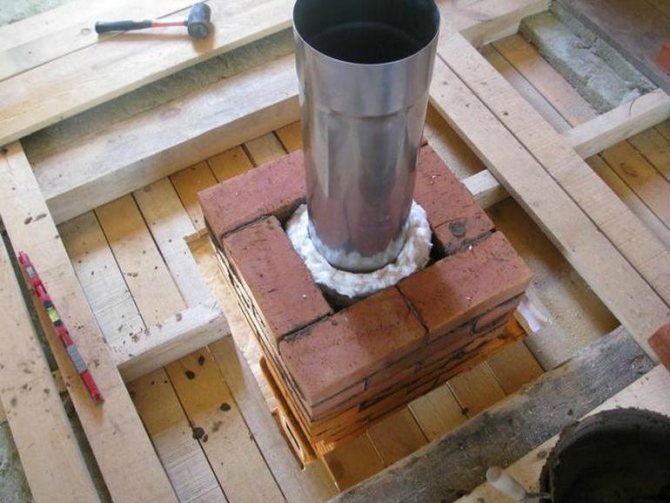

Casing (sanitation) of the chimney
Casing (sanitation) of the chimney - installation in an existing smoke and (or) ventilation duct, without its complete dismantling, a repair insert - a pipe.
This insert is named - sleeve.
Installing a sleeve into the channel is necessary whenever:
- There is an indication of the alignment and protection of the walls of the chimney (sleeve) in the project;
- Low temperature connected TGA;
- It is necessary to make a coaxial chimney, a gas-air system (LAS), for the simultaneous supply of air for combustion and removal of combustion products into the atmosphere;
- The stove or fireplace will be used in continuous burning mode;
- Large chimney length;
- The chimney is installed in the outer walls;
- Long chimney in unheated rooms and above the roof;
- The destruction of the walls of the chimney is observed;
- Depressurization of the channel and violation of gas tightness are observed;
- Condensation drips are observed on the walls.
The liner of smoke ducts is also often called lining, i.e. protection of the walls of the channels from the inside from the aggressive effects of high temperatures, as well as freezing, the precipitation of acids and water, both from condensing vapors and from atmospheric influences. Due to the formation of an aggressive environment, destruction often occurs, both of the chimneys and the structures of the building in which they were installed.
These unpleasant moments often arise as a result of:
- incorrectly selected material, taking into account specific operating conditions:
- Brick chimney;
- Washing out the solution;
- Low temperature boiler;
- Low temperature outside;
- Hygroscopic materials and other omissions. - design errors;
- Location in the outer wall;
- Lack of thermal insulation;
- Head design;
- Lack of condensate drainage;
- Other omissions and negligence of the designer.
- installation errors and violation of the rules for its conduct:
- Smoke assembly direction;
- The head and the sealing of the roof were carried out with a deviation from the project;
- Damage (jammed and scratched ends) of the pipe during installation;
- Incorrect and not reliable Fastening, condensate drainage, kinks and bends;
- Docking leaks;
- And other inconsistencies due to the devil-may-care attitude of workers and weak control by the work supervisor.
- Violation of operating rules:
- The use of inappropriate fuel, as well as the failure of the TGA operation settings;
- The use of an inappropriate operating mode (intense combustion, or smoldering, premature transfer to prolonged combustion, etc.)
- Other negative points associated with the operation of the TGA or building.
- Inadequate maintenance:
- Untimely cleaning, inspection and maintenance;
- Failure to carry out scheduled repairs and periodic activities;
- Other violations of the Terms of Service.
Part 1. Materials for sanitation (liners) of chimneys.
1. Stainless pipes .
The most commonly used material for the repair and restoration of chimneys using the sleeve method.
At the moment, stainless steel pipes used for these purposes can be conditionally divided into the following three groups:
- Round pipes .
They are produced from ferritic and austenitic steel grades, various diameters from 60 mm to 1000 mm, and thicknesses from 0.5 mm to 1.5 mm. Fittings are produced in the appropriate sizes, from the same steels and thicknesses. They are installed in any channels and shafts that exceed the size of the insert diameter.
Produced by major Russian manufacturers: Craft, TiS, Volcano, Ferrum and others and imported: Schiedel, Jeremias, BOFILL;
- Oval sleeves.
The main dimensions are 100 * 200 mm and 120 * 240 mm. Suitable for round diameters 150 and 200 mm. Used stainless steel sheet with a thickness of 0.5 and 0.6 mm, mainly austenitic steels. Shaped parts are used from the same steel grades as the main ones, or a transition to a circular section is performed. Installed in channels of rectangular cross-section, called "pyaterik" 140 * 270mm, or in a common shaft with other pipes, in order to reduce the size of the box or shaft.
Manufacturers: Craft, TiS, Volcano;
- Flexible (corrugated) pipes.
Corrugated round tubes made of two layers of stainless steel. At the same time, the steel grade is only austenitic, but used internally and externally may differ. The main grade used for the production of flexible pipes is AISI 316L. Pipe diameter from 80 mm to 350 mm. Can be installed in curved canals. The turning radius is 2-3 times the pipe diameter. The fittings are made of round stainless steel sheet.
Examples of flexible gas duct manufacturers: (LISFLEX) BOFILL; Tubest TS Multinox.
Pay Attention! Use of flexible aluminum air ducts as flue ducts and chimney connections is unacceptable!
2. Ceramic pipes.
Ceramic is one of the most reliable and durable options for rehabilitating collapsing smoke channels.
It is not used for ventilation only due to its high cost. It is important to choose the right pipes and accessories for them.
Currently produced ceramic pipes for sanitation can be divided into the following groups:
- By manufacturers: Schiedel ; Tona; Hart; Wolfshöher; Plewa; Heluz; other;
- Shape: Rectangular and round;
- Based on materials: Fireclay and ceramic;
- By production methods: Plastic molding or isostatic semi-dry pressing;
- By connection: thorn-groove, or bell system;
- By application conditions: flame retardant soot (G) or not flame retardant soot (O);
- According to the mode of application: Dry (W) or Wet (W);
- Corrosion resistance class: W1 (gas); W2 (liquid and gas); W3 (solid, liquid, gas).
- For work under increased pressure, or under rarefaction and located inside or outside the building:
N1 (leakage 2.0 l * sec / m2, at a vacuum of 40 Pa, located inside or outside the building)
N2 (leakage 3.0 l * sec / m2, at a vacuum of 20 Pa, located inside or outside the building)
P1 (leakage 0.006 l * sec / m2, at a maximum overpressure of 200 Pa, located inside or outside the building)
P2 (leakage 0.120 l * sec / m2, at a maximum overpressure of 200 Pa, location outside the building, when operating in rarefaction mode, location inside the building is allowed)
H1 (leakage 0.006 l * sec / m2, at a maximum overpressure of 5000 Pa, location inside or outside the building)
H2 (leakage 0.120 l * sec / m2, at a maximum overpressure of 5000 Pa, location outside the building, when operating in rarefaction mode, location inside the building is allowed)
- By the maximum application temperature;
- By the presence of a protective coating: Glazed and non-glazed;
- By diameters: from 120 mm to 450 mm;
- For the maximum section of a straight pipe: 330 mm, 660 mm, 1330 mm;
- By weight: heavy and lightweight;
- Wall thickness from 4.0 mm to 20 mm. Shaped parts of the ceramic chimney system can be provided by the manufacturer, both in ceramic and in stainless steel.
Examples of chimney refurbishment systems from various manufacturers:
- Schiedel KERANOVA;
- TONA tec san;
- Heluz Kerasan plus.
3. Asbestos-cement pipes.
Contained in the list of materials acceptable as chimneys, however, there are a number of significant restrictions.
The smoke temperature should not exceed 300g. This implies:
- Afraid of soot catching fire;
- Cannot be used for coal-fired TGA;
- It is not allowed to use as a chimney for TGA, the temperature of flue gases of which may exceed 3000C;
- It is unacceptable to use with non-certified TGA;
- Obligatory timely cleaning.
The material is hygroscopic. It follows from this:
- Cannot be used with condensing and low temperature boilers;
- Cannot be frozen;
- It is necessary to insulate yourself during installation;
- Difficulty of docking;
- Lack of shaped parts;
- And a number of other restrictions.
Despite all the above negative points, asbestos-cement pipe, at the moment, remains the cheapest, and therefore the most widespread material for chimneys.
Attention! An asbestos-cement pipe as a chimney is not safe!
Be extremely careful and careful when operating a chimney with an asbestos-cement pipe!
4. Polymer sleeve (liner)... A new composite material consisting of a fiberglass mesh - a base and a resin type of polymer impregnation.
At the moment, on the market of chimney products, liners of flue channels are offered for removing combustion products from boilers (and other low-temperature TGAs), as well as for smoke channels used for fireplaces and stoves.
Distinctive features. Positive:
- There are no seams and joints;
- Low thermal conductivity;
- Not afraid of moisture and acid;
- Fast installation;
- No need to open the wall, even to turn;
- It is possible to turn by an angle of up to 30 degrees (some documents indicate an angle of 45 degrees, however, for such a turn, there is a high probability of the formation of creases and bends with narrowing);
- The minimum number of alterations to building structures, preparatory and related materials;
- Available diameters from 80 mm to 500 mm;
- The maximum possible length is 60 meters;
- The chimney fittings are made of austenitic stainless steel.
Distinctive features. Negative:
- Installation requires special equipment;
- Narrowing of the channel cross-section is possible;
- The participation of qualified specialists is required;
- Eliminates self-assembly;
- There is a possibility of damage to the sleeve when installing fittings and pulling in the channel;
- The high cost of material, equipment and work.
Examples of polymer liners supplied to Russia:
- FuranFlex for gas boilers certified as: T250 H2 0 W3 R6 C50
- FiTFiRE for low temperature boilers. European classification: T 300 P1 W1 O 50 R0,017
- FuranFlex RWV for fireplaces and stoves: Designed for smoke temperatures up to 800 degrees. Cannot be used for low temperature TGA.
- FiTFiRE HT 1000 is similar to the above.
5. Plastic pipes... Their use is permissible in cases of using certified TGA and certified plastic pipes provided by the manufacturer for this purpose.
It is the fact of using only certified plastic pipes that nullifies any benefits of using plastic, because the cost of pipes from it will be equal to a good stainless steel insert made of acid-resistant steel.
Sewer plastic pipes can only be used in non-combustible mines, as supply or exhaust ventilation, as well as supplying combustion air to a TGA with a closed combustion chamber.
note, the laying of plastic pipes through the building envelope will reduce the fire resistance of these load-bearing and enclosing structures to zero, and therefore the survivability of the entire building. After ignition in only one room, the flame will instantly spread throughout the building and even before it is detected and localized. This means that we get combustion throughout the entire area of the building, including the floors and the roof, which will greatly complicate the evacuation of people and extinguishing the fire.
The use of a sewer plastic pipe as a chimney is strictly prohibited!
Part 2. Carrying out works. Preparatory stage. Before the start of work.
The installation of the liner into the smoke channel begins long before the arrival of a qualified team at the customer's site and includes:
Drawing up an installation scheme, designing, drawing up a complete set of materials, agreeing on an estimate and signing an agreement with the customer. This is all a preparatory stage.
The installation diagram, in a simplified version, or the draft of the chimney liner, must necessarily contain answers to the questions:
- Chimney diameter (possible transitions from diameter to diameter are displayed and explained)
- Chimney height in relation to the ridge, floors and connection point;
- Chimney and support loads;
- Chimney fastening (supporting element that takes the load);
- Condensate drainage (select the direction of the condensate drainage method and the corresponding chimney system element);
- Inspection and cleaning devices (tees, pockets, plugs);
- Docking in the TGA (the exact diameters are determined, the need for adapters and adapters);
- Straightness of the laying (required bends, angles of turns, slopes and length of each of the sections);
- Liner centering and alignment (distance clamps, spacers, etc.);
- Sealing joints (applying sealant, clamps, etc.)
- The need for thermal insulation (type, thickness, length and volume);
- Head type and structure;
- Work production plan.
At the beginning, according to the list of works and the approved estimate, the installation team assembles the tools, equipment, personal protective equipment and accessories for installation that it needs. Next, a chimney kit is assembled, including auxiliary and fasteners. The quantitative composition is checked according to the estimate and invoices.
Before the start of work, all openings must be completed, the locations of the chimney fasteners must be determined and the paths for approaching the pipe must be prepared both in the task and on the roof.
Also, the necessary scaffolding and ladders are being erected, the safety of the installation work is checked and safety devices are attached.
At the appointed time, the installers must arrive at the work site.
First stage. Start of installation.
In case of previously not completed works of the preparatory stage, the work listed in the preparatory stage is carried out. If necessary, dismantle the old chimney.
After the installation of approach paths and technological openings in the mine, the channel is thoroughly cleaned using a ruff, and at the same time it is checked for patency.
If necessary, the influx of solution is knocked down and the walls of the channels are leveled through the top or additional technological openings.
A winch is attached to the mouth of the pipe for lifting and lowering the liner.
Components are distributed across floors.
The bottom of the mine is leveled.
When placing the support element at the bottom of the channel, the bottom of the shaft is prepared and leveled, and a ventilation hole is provided with a condensate drain connection.
Second phase. Installation of the main kit.
Features of mounting various inserts (sleeves).
All operations are reduced to laying a sleeve to the entire height of the shaft, connecting a consumer to it, fixing it and leveling it.
However, there are a number of significant differences in the installation operations of various types of liners. The most significant ones are listed below.
Features of mounting an oval or round stainless steel sleeve:
- The condensate drain, support element and tees are installed in the technological opening in the lower part of the shaft, and the entire main pipe descends from the roof;
- The pipe is fastened to the winch with rubber straps, or a crimp clamp fixed to the lower pipe;
- Tip: The pipe will run smoother into the mine using two cables;
- If the height of the sleeve is not high, it is allowed to hold the pipe by the upper part, with reliable fixation of the pipe elements relative to each other;
- It is advisable to connect the elements of the lilzy with each other without self-tapping screws. In exceptional cases, the use of stainless steel rivets is allowed.
- The chimney is installed at the bottom of the shaft by means of a floor element with a side condensate drain, or by means of a support platform, through to a fastening element fixed on the walls of the shaft;
- For centering and aligning the pipe shaft in the mine, distance clamps and spacer structures are used;
- When turning the sleeve, it is imperative to make a technological opening for the entire amount of rotation, on both sides of which it is necessary to fix the sleeve;
- Application of high-temperature sealant (up to 300 g) is recommended for gas and liquid fuels and Heat-resistant (up to 1200 - 1500 degrees), recommended for solid fuels;
- The sleeve ends above the mouth of the shaft.
Features of mounting a ceramic sleeve:
- The condensate drain, in this chimney system, is a supporting element, so the entire assembly begins with it;
- A special element - a roller stand, is threaded into the hole in the condensate trap intended for it and is installed on the winch cable, after which it descends into the shaft by 20-30 cm; Pay attention to the direction of the condensate drain hole!
- Spacers are installed on the side surfaces of the condensate drain and a sealant is applied. (The type of sealant is determined according to the type of fuel used.) After that, the first ceramic pipe is glued and lowered downwards, having previously aligned the joint from the inside with a damp sponge
- In the first pipe, before connecting to the condensate trap, according to the template, holes are made for the universal fitting at the calculated height, relative to the bottom of the shaft. It is rare that the hole for the consumer connection falls on the same pipe. Important! The nipple must not come into contact with the socket joint! Pay attention to the direction of the connection hole!
- After applying the sealant to the socket of the first pipe, a cuff with spacers is installed, and the pipe goes down 20-30 cm below the mouth of the shaft;
- A second pipe is installed, after which the squeezed out sealant is selected for the seams with a seam leveler and the joint is smoothed. Make sure that the drilled holes for the nipple are correctly oriented with respect to the shaft!
- Operations are repeated until the bottom of the mine is reached;
- The pipe should protrude from the shaft masonry to the height of the cover plate and the cone.
Features of mounting a flexible stainless steel pipe:
- The flexible duct descends from the roof under its own weight. It is recommended to make a plug that is inserted inside and by fixing the cable to it, direct the air duct by pullingdown (especially important for laying a flexible insert in a shaft with a bend).
- Connection, inspection and condensate drainage are performed by sets of stainless steel pipes of austenitic grades;
- All fittings must be securely fixed in the shaft;
- The transition to round stainless steel pipes is carried out with a special adapter fixed with a clamp.
- The pipe is cut 20-30 cm above the pipe mouth;
- It is better if the upper part of the flexible duct ends with an adapter and a round insert with attachment to the shaft.
Features of mounting a polymer liner:
- The polymer sleeve is lifted by a winch cable fixed at the pipe mouth from the bottom up. The use of special equipment (winch) is recommended.
- A special element with a pressure gauge and a valve for bleeding air and steam is installed in the upper part of the liner;
- By pumping the air compressor, the liner expands in the channel taking its shape;
- After the expansion of the liner, steam is injected under a certain pressure;
- Having created the required pressure and temperature, this mode is maintained for a period of time determined by the manufacturer;
- After some time, the composite material polymerizes;
- After polymerization (hardening) of the insert, the mounting elements are removed;
- Connection, inspection and condensate drainage are performed by sets of round pipes made of stainless steel of austenitic grades;
- Fittings are securely attached to the wall or in the shaft;
- The transition to round stainless steel pipes is carried out with a special adapter fixed with a clamp.
- The liner is cut flush with the shaft, with the installation of the final element at the pipe mouth.
Stage three. Head device.
The field of performing the basic installation operations, it remains only to correctly design the mouth of the sleeve chimney.
Here are the basic requirements and recommendations for the headset device:
- The liner, or liner guide, must rise above the shaft;
- A cover plate is installed around the protruding sleeve;
- In its absence, a plate is made of metal or is made with a cement-sand mortar with a slope from the pipe;
- A collar is installed near the pipe to prevent moisture from entering the space between the pipe and the shaft, or a mortar protrusion is arranged with the obligatory trick of a gap for expansion;
- The mouth of the pipe is directed vertically and cut horizontally;
- It is recommended to insulate the protruding part above the roof and in a cold attic with non-combustible materials;
- It is recommended to install an umbrella to prevent atmospheric precipitation from entering the pipe, especially if the condensate drain does not have a permanent connection to the sewer;
- The use of a chimney deflector is not recommended;
- To increase the height of the pipe, its design and completion, it is recommended to switch to a heat-insulated sandwich chimney using factory-made parts;
- Thermal insulation of the liner with bulk materials is not allowed;
- To arrange ventilation channels, a special cuff with a cone is used, or air vents are arranged in the lateral surfaces of the shaft below the cover plate.
Part 4. Errors in the construction of the chimney and its sleeve.
What you should pay attention to.
- The use of straight pipes without a condensate drainage device, revision and connection does not correct the problems and is a senseless waste of the customer's funds;
- Gilding the chimney at the same time as laying the walls and the shaft is the most correct and prudent decision;
- Partial casing of the channel moves the places of condensation to other places and does not correct the problem;
- It is recommended to make a sleeve if the smoke channels were laid by masons, and not by stove-makers;
- The chimney can be sleeved with a heat-insulated sandwich chimney;
- The use of thermal insulation in the channel for the expansion gasket device and to accelerate the passage of the dew point is allowed, but not required;
- The use of a bend (knee) as a support is unacceptable;
- Jamming of the edges of the pipes leads to difficult joining during installation and (or) to depressurization during operation;
- Sharp jerks by the cable of the lowered flexible chimney are not allowed, since creases, dents and chimney disassembly are possible;
- The narrowing of the chimney is prohibited!
- Drainage of condensate from the condensate trap located in the wall will not be possible if a pipeline for its drain is not previously laid, or access to it in the form of a ventilation grill, hatch, or door is not provided;
- Condensate drainage is recommended to be done with a hose connected to the sewage system through a "U" shaped water seal, which excludes moisture from the sewer system and air leaks provoking a weakening of the draft;
- Sharp turns of the flexible pipe or liner lead to creases and narrowing of the section;
- The chimney must be placed freely in the shaft;
- Locking the chimney with brickwork, or backfilling with heat-insulating substances is pointless and can even lead to negative consequences in the form of crushing parts of the pipe, collapsing and self-disassembly;
- When a section of the wall in the area of \ u200b \ u200bthe passage of the roof with a chimney gets wet, first of all check the tightness of the roofing and the removal of condensation moisture from the waterproofing membrane. Most often this is a violation of the tightness of roofing structures and is not associated with the operation of the chimney;
- When installing a chimney and its sleeve, cleaning and inspection devices should be provided along the entire length of the pipe;
- Check the height of the chimney in relation to the ridge and the area of wind shade created by tall trees and other obstructions, even though the chimney has existed in this form before. Perhaps there are associated deviations or problems;
- The reasons for backdraft can be not only in the height or correctness of the chimney device, but also in the structure of the building, wind currents and drafts created in the room in the building;
- It is advisable to carry out all work with the chimney before finishing and final roofing.
Part 5. Advantages of chimney rehabilitation (liner).
A sleeve channel is better than one without sleeve, because it has:
- Ideal (optimal) cross-section for gas movement;
- The minimum roughness (smooth) of the inner surface of the pipe;
- Wall material that does not get wet and does not absorb moisture;
- Less thermal conductivity and flue gases are cooled less when passing 1 meter of the channel;
- Greater safety when the insert is depressurized;
- High speed of heating the pipe in cold weather;
- Protection of masonry in case of condensation;
- Condensate collection and drainage devices;
- Possibility of reducing PP pipe grooves in the interfloor passage;
- Correctly arranged head that does not absorb moisture and is protected from freezing (destruction);
- Smooth surface that is easy to clean;
- Possibility of replacing the insert.
Because of all of the above, we conclude that a sleeve-type chimney is denser, more reliable and safer.
And it is also worth mentioning that when repairing a chimney, using the sanitation method, it is possible to install a liner without disassembling the wall, and the liner itself will be more maintainable and less costly.
The liner process will take place much faster than the construction of a new one, which will bring a positive economic effect and will favorably affect the cleanliness of the work and the useful space of your home!
I hope this article has answered many of your questions and you now have an idea of how to sleeve smoke and ventilation ducts.
Alexey Telegin
Three common sleeve methods and materials used
The main essence of the liner is the insertion of the liner into the brick shaft. The liners differ in the material of manufacture, size, shape. The basic principle of installation is the same, but there are nuances.
Stainless steel
The liners are characterized by a long service life, resistance to high temperatures and condensation. Stainless pipes are suitable for shafts of any length and shape.
Stainless steel inserts differ in execution:
- Round pipes are produced with a cross section from 6 to 100 cm. The wall thickness depends on the metal used and is 0.5–1.5 mm.
- Rectangular pipes are used less often. When requested, inserts with a wall size of 14 × 27 cm are used.
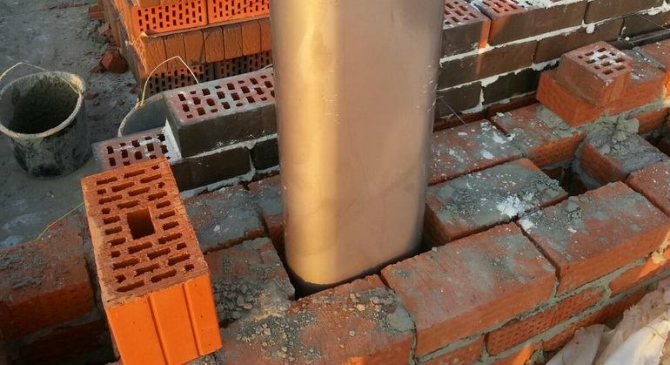

- Oval pipes are made of stainless steel with a thickness of 0.5-0.6 mm. The running dimensions are 20 × 10 and 24 × 12 cm.The section corresponds approximately to a round pipe with a diameter of 15 and 20 cm.
- Corrugated sleeves are made of two layers of different grades of stainless steel. The cross-section varies from 8 to 35 cm. During the installation of a flexible stainless steel chimney, you must not bend the corrugation with a radius of less than two pipe diameters.
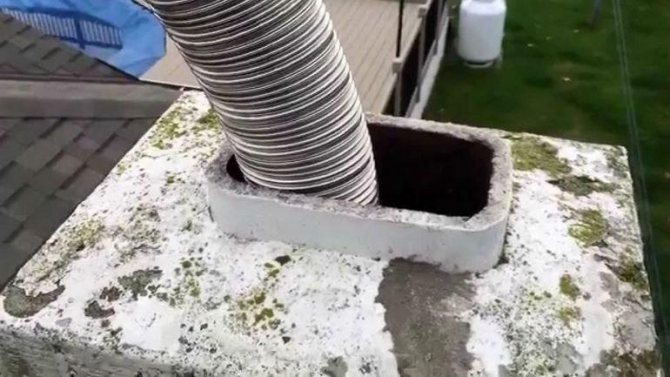

Of all the options, a corrugated sleeve is considered the most unreliable. Two-layer stainless steel burns out in four years from exposure to high temperatures, and soot lingers on the ribbed walls.
Polymer sleeve
The sleeve is made of fiberglass mesh impregnated with polymer resin. The one-piece hose is inserted into the shaft without the use of connecting segments. If necessary, use fittings. Maximum sleeve length - 60 m. Thickness - from 8 to 50 cm. Service life - up to 30 years. For high-temperature and low-temperature boilers, sleeves of different composition are used.
FuranFlex polymer systems for gas boilers, fireplaces and stoves are popular in Russia.
FiTFiRE liners are used for low temperature boilers. FiTFiRE HT 1000 is suitable for fireplaces and stoves.
Sleeve sleeve allows you to get a one-piece channel without disassembling the brickwork of the mine. The liner is resistant to condensation and is capable of bending at an angle of 300. Among the disadvantages are the high cost, as well as the impossibility of self-assembly of the flue gas duct without skills and the presence of special equipment.
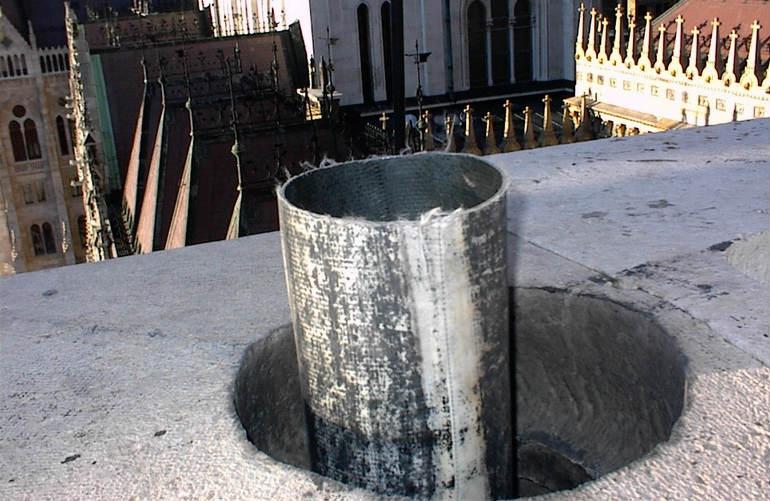

Ceramics
Ceramic liners are considered reliable and durable. For casing they are more often used in the restoration of destroyed mines. Elements are available in round and rectangular shapes. The connection takes place in a socket or a thorn-groove lock. The diameter of the sleeves is from 12 to 45 cm. Straight pieces of pipe are produced in lengths of 33, 66 and 133 cm. The wall thickness varies from 4 to 20 mm.
Ceramics are not afraid of soot ignition. The downside is the high cost and weight. Installation is not complete without dismantling the chimney shaft.
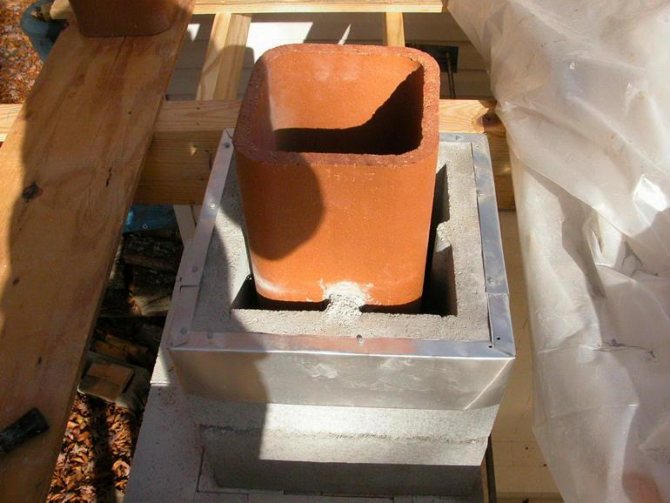

Varieties of sleeve
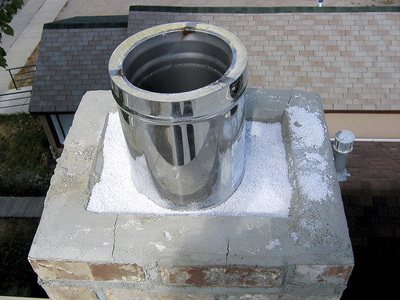

Casing with a sandwich pipe
The principle of behavior of lined liners and their placement in the channel is the same, but the liners differ in material, so there are certain nuances for each type.
Specialty stores offer inserts:
- from polymers;
- of steel;
- from a corrugated pipe;
- polymer sleeve;
- made of stainless steel.
The inserts are selected depending on the preference of the owner and his capabilities. Consideration is given to durability, acidity and weather resistance.
Polymer sleeves
A plastic pipe is installed inside the operated chimney. PVC products are reinforced with fiberglass fabric and become plastic when heated. As a result of this property, irregularities and spaces on the clinker surface are filled. After hardening, the inner area becomes smooth, and the wall is 2 cm thick.
The disadvantage of using is temperature limitation. The liner of a chimney made of bricks with plastic is made with diverted flows up to + 250 ° C, therefore they are set to work with low-power units.
Application of steel elements
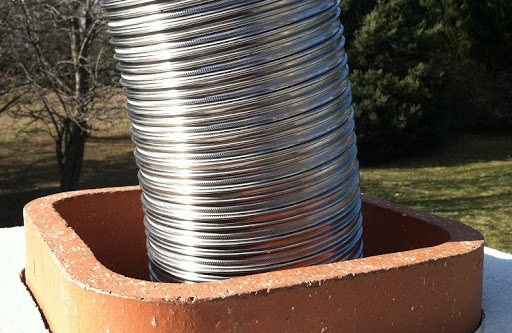

Sleeving with a corrugated pipe
In the straight section of the chimney, a structure made of a rolling pipe is placed or rectangular, square, oval and round shapes are made with their own hands. Sheets are taken with a thickness of 0.5 to 1.5 mm. In ducts made of steel materials, it is possible to provide the required modules for cleaning, inspection, tanks for accumulating condensate in accordance with the standards.
Steel products are used for hearths using various types of fuel. The material resists the action of acids, is not susceptible to plaque deposition. The disadvantage is that only straight sections can be sleeve using this method, meandering pipelines cannot be equipped.
Use of corrugated pipe
Manufacturing is carried out using various types of stainless steel, pipe shells are made in two layers. On the positive side, flexible liners are used for difficult canals with curves. The products do not require connecting elements. Double-layer inserts significantly reduce the diameter of the duct, this must be borne in mind when choosing.
Corrugation is rarely used to protect the chimney of a sauna stove, because highly heated combustion products are discharged in the duct. The disadvantage is the raised surface of the element, which contributes to the deposition of plaque.
Polymer sleeve
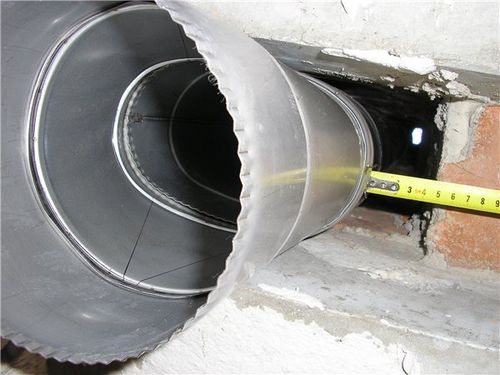

Polymer sleeve for chimney sleeve
The sleeve is made of copolymer resin, reinforced with fiberglass. The insert is used to combat condensate drops, low-temperature chimneys and those that come from powerful boilers are processed with it.
Varieties of polymer products:
- Fitfire is a two-layer liner, the maximum element is 60 m long. After installation, the flue gas duct has a diameter of 80 - 500 mm. The manufacturer defines a service life of 50 years, the sleeve is used to remove low-temperature gases.
- Fitfire HT 1000 is used in the pipes of baths and fireplaces with high smoke temperatures. The sleeve consists of three layers, the middle layer is a reinforcing mesh.
When the chimney is cased with a polymer sleeve, the inner protection is obtained without seams, with a smooth surface.
Stainless pipe
The material is one of the most popular types. Products work for many years, do not deform due to high temperatures, corrosion. The sleeve lining of a brick chimney with a stainless pipe is often used, because there is a large assortment of ready-made inserts on sale, sometimes the products are made with their own hands, taking into account the sizes.
Inserts are made of stainless steel sheets with a thickness of 0.8 - 1.5 mm. To connect, turn the channel, standard tees and branch pipes are used, but to install them, you need to know the exact layout of the smoke ducts. Sleeves with rectangular cross-section are installed only on straight sections of chimneys.
Features of mounting liners made of different materials
In modern construction, stainless steel, ceramics or a polymer sleeve are used for the reconstruction of a chimney. Ceramic liner and polymer are difficult to mount. Most often, when casing chimneys with their own hands, they use stainless steel.
Preparatory work
Regardless of the type of liner chosen, a number of preparatory measures are performed before starting the liner:
- Using a powerful flashlight, they inspect the smoke shaft from the inside. Determine the degree of destruction, contamination with soot, the presence of fallen off pieces of mortar, bricks, bird nests.
- They clean the chimney with metal scrapers, brushes and other devices. Bricks protruding from the masonry will prevent the insert from being inserted. They try to knock down all the protrusions with a hammer or a pry bar.
- Measure the length as well as the diameter of the chimney. The dimensions are transferred to the diagram, indicating all the rotations and degrees of the angles.
- The part of the chimney adjacent to the boiler or stove is disassembled. From this point, the installation of the shaped element will begin.
- The bottom of the smoke shaft is cleaned of debris and, if necessary, leveled.
After the preparatory measures have been taken, the liners necessary for the liner are bought.
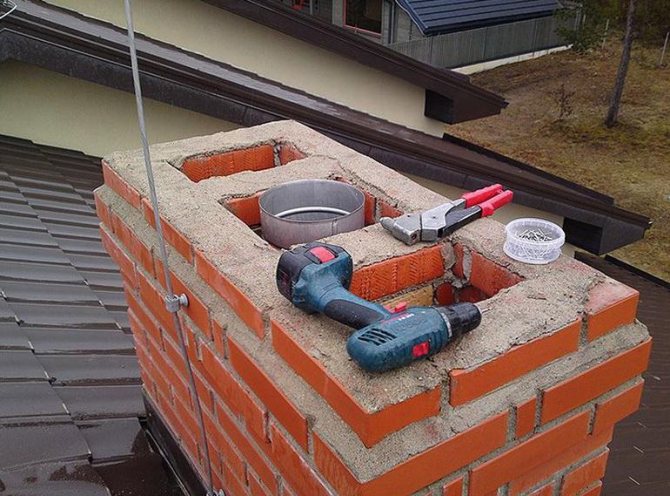

Installation of a stainless steel insert of a round, rectangular or oval section
The stainless steel sleeve of a small mine without turns is performed according to the following principle:
- All elements of the sleeve are assembled into one structure. The joints are treated with a heat-resistant sealant, and from above they are wrapped with adhesive tape on an aluminum base.
- Two belts, cables or strong rope are fixed to the bottom of the pipe with a clamp.
- The sleeve is carefully lowered along the shaft until it stops at the bottom. If the length of the chimney is small, a light stainless steel pipe is immersed by hand without using cables.
- The insert from below is connected to the inlet of the boiler or furnace and a condensate collector is installed. From the street, the sleeve is taken out above the brickwork of the chimney, and a protective cap is put on from above.
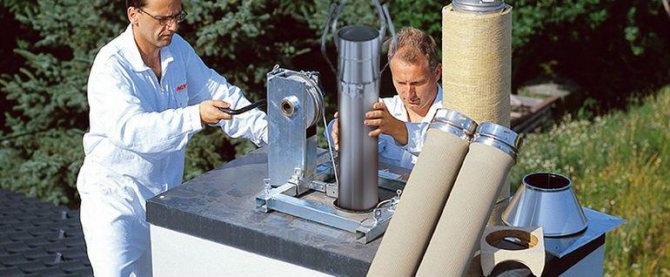

The stainless steel sleeve of a long chimney with turns is carried out differently:
- The flue duct is disassembled at the entrance to the boiler, as well as all areas where shaped connectors will be installed.
- First, the lower part of the sleeve is assembled from the flat sections of the pipe to the first shaped connector. The liner is lowered to the bottom of the shaft, connected to the inlet of the boiler or furnace, and a condensate collector is installed from below.
- A shaped connector is installed on the second free end of the steel sleeve. A flat section of stainless steel is connected to it until the next turn of the mine. The procedure is repeated until the sleeve is removed from the shaft.
The pipe joining section is similarly reinforced with a heat-resistant sealant and wrapped with aluminum tape. A head is installed on top.
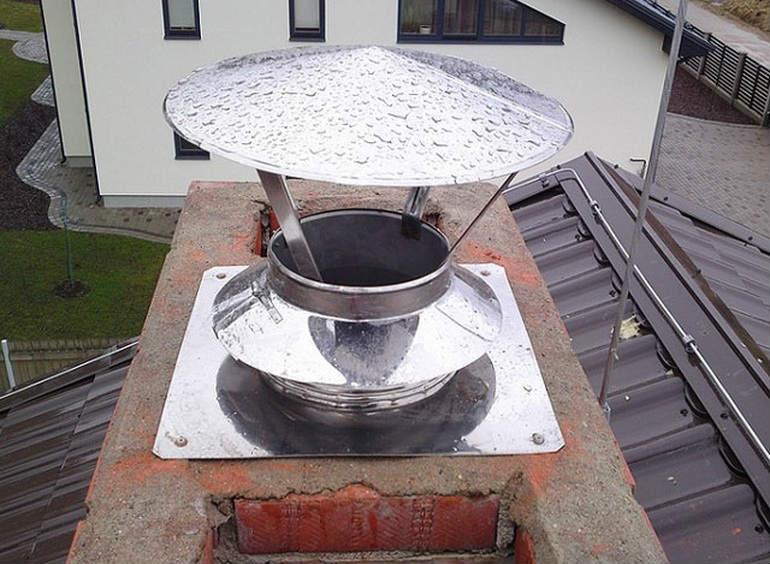

Installation of stainless steel corrugated hoses
Casing with corrugated stainless steel smooth and with turns of the chimney is carried out in a similar way. The difference is the arrangement of the lower and upper exit from the mine. After installing the flexible hose inside the smoke channel, a rigid transition from a stainless pipe is attached from below. This section connects the sleeve to the inlet of the boiler or furnace. A condensate collector is installed below.
At the upper outlet from the smoke channel, the corrugation is brought out above the masonry about 30 cm. For the reliability of the head's attachment, the exit can be made by building up a rigid section of a stainless pipe. At the end of the sleeve, the brickwork of the chimney is restored.
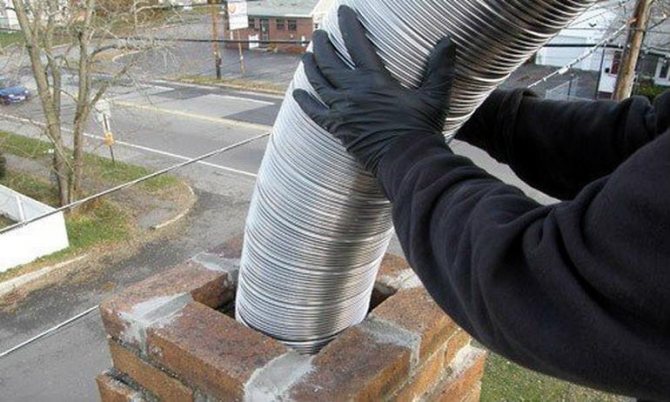

Installation of the ceramic insert
Casing with ceramic liners is more difficult. The process consists of the following steps:
- The roller mechanism is fixed to the holes of the condensate collector. The element in the sleeve is a supporting structure, and the first one descends into the chimney to a depth of 30 cm. Ceramics are heavy. For a safe descent, it is optimal to use a winch.
- The upper end of the condensate collector is treated with a sealant. With the help of a socket or a thorn-groove lock, a flat section of the pipe is fixed.
- To connect the boiler using a universal fitting, a hole is cut on a flat ceramic sleeve. A part of the liner is lowered into the shaft with a winch. The next element is fixed to the end of the first pipe in a similar way.During the descent, make sure that the sleeve does not turn in the other direction with respect to the boiler inlet with the hole for the fitting.
When the condensate collector reaches the bottom of the shaft, docking with the boiler inlet is carried out. From above, the ceramic pipe is brought out above the brickwork. The protrusion is made equal to the height of the cover plate.
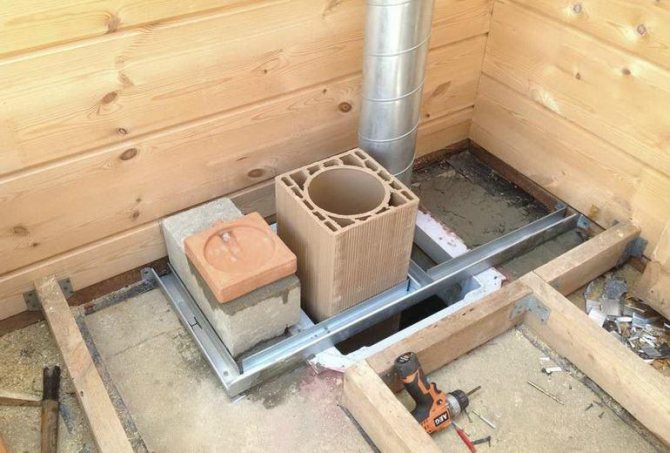

Installation of a polymer sleeve
For casing the chimneys with a polymer sleeve, special equipment is required. Initially, the liner resembles a coiled hose. The sleeve is raised to the roof of the building, introduced through the channel to the bottom of the mine, connected to a compressor and air is supplied. Under pressure, the soft walls of the stocking will expand.
When the sleeve acquires the inner shape of the channel, steam is supplied instead of compressed air. The polymer first softens and then hardens. The condensate collector is being installed below. At the exit from the mine, an extra piece of the sleeve is cut off, and a head is installed on top.
Head device
To install the head, a rigid sleeve is built up on the surface of the chimney, and a cover plate is mounted around it. A collar is attached near the pipe to prevent condensate from entering the brick shaft. The part of the sleeve protruding above the roof of the house is insulated with insulation. In height, the pipe should go beyond the level of the ridge.
Frequent mistakes
When using any type of liner, it is impossible to allow narrowing of the sections, use a shaped turn for the stop, and also pour loose insulation into the gaps between the liner and the walls of the shaft.
It is not allowed to drain condensate into the sewer through a hose without arranging a U-shaped water seal.
It will be useless to work with a partial shaft sleeve, as well as the presence of steep corners.
Benefits of refurbishment
The chimney remediation process has undeniable advantages:
- the smooth inner surface of the chimney weakly retains soot;
- the thermal conductivity of the mine decreases, due to which the pressure difference is maintained;
- liner walls made of any material do not absorb condensate;
- a compensator is added for assembling and draining condensate from the channel.
A failed liner is always easier to replace than to re-lay a brick shaft.
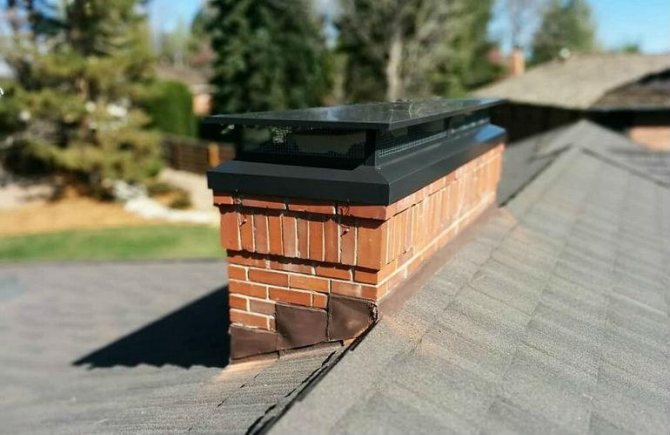

Self-casing of a brick chimney
Before carrying out the procedure for casing a brick chimney, it is necessary to perform a number of preparatory work. You need to measure the height of the pipe, select the diameter of the inner pipe and the outlet pipe. For a square section of a brick chimney, round pipes are chosen, for a rectangular one - oval.
Also, before the procedure, it is necessary to inspect the chimney well and make sure its integrity, make sure that there are no cracks, cracks and blockages in the pipe. After that, you need to prepare all the necessary materials: you need to acquire a suitable type of pipe, adapters, a tee with a branch, cleaning with a sealant, balsam wool, a protective umbrella, etc.
The next stage is the installation itself. To install auxiliary structures, you need to make holes in the brickwork, so you make your work easier. So, a tee with a condensate drain is installed. Filling the chimney with your own hands is carried out from the roof, therefore, for safety reasons and the requirements for performing installation work at a height, it is necessary to use insurance. Using the first element tied on a rope, dock with the next, slowly lowering the structure.
The pipe joints must be treated with a heat-resistant sealant and fastened with locks, so you will provide them with high reliability. Then, in the space between the pipe and the brick wall, it is necessary to install refractory insulation. After that, the head is installed and the protection against precipitation is installed. The last stage of plugging is the restoration of the disassembled masonry and the connection of the heater.
Thus, sealing is a responsible procedure.Therefore, if you do not have enough experience and you are not sure that you can do the job efficiently, contact the specialists.
Estimated cost of work
The cost of refurbishment depends on the materials and design of the future chimney plug. For the installation of an insert with a length of 1 m, you will have to pay about 2.5 thousand rubles. After measuring the length of the shaft and multiplying the results by the cost of the selected liner, you can roughly calculate the cost of refurbishment.
We hope that the information provided will help you choose the appropriate sleeve method and do all the work yourself. We suggest subscribing to other useful articles. Share information on social networks. Maybe a person is similarly looking for ways to solve a similar problem.
(
1 estimates, average: 5,00 out of 5)
Stages of sleeve installation
Below we will consider how to correctly perform the sleeve in different ways (according to the type of materials that were discussed above). Please note: it is quite difficult to do such work yourself if you do not have extensive experience in construction.
Preliminary work
Before proceeding with the liner, it is necessary to prepare the existing smoke channel.
Phased actions (the instruction is relevant for any method of sleeve
):
- The state of the chimney from the inside is assessed. To do this, you need to visually inspect it with a flashlight. Attention should be paid to the level of contamination and damage, if any.
- It is checked whether there are any obstacles inside: protruding bricks, mortar flows, protruding pieces of reinforcement, or dirt - bird nests and other debris. If problems are found, they should be fixed.
- Just in case, you can double-check the length and cross-section of the channel.
- The channel is cleaned mechanically (with a brush). Optional but recommended item.
- A part of the smoke shaft is disassembled from below (the area that is adjacent to the boiler / fireplace and the areas in which it will be necessary to mount the fittings.
- The bottom of the mine is leveled.
Next, we will consider the features of the sleeve in each way.
Sleeve with ceramic pipe (video)
Stainless
If the chimney is small and has no turns, the work looks like this:
- Only the lower section of the main shaft is disassembled.
- The sleeve is assembled from component parts. The elements are fastened together with aluminum tape. For gas and liquid fuel boilers, a high-temperature sealant is additionally used (designed for temperatures up to 300 °), for solid fuel boilers, a heat-resistant sealant is used (for temperatures up to 1200 °).
- A rubber strap or crimp clamp is attached to the bottom of the sleeve.
- 2 cables cling to the belt or clamp.
- On the cables, the sleeve smoothly lowers to the bottom of the mine.
- If the full length of the sleeve is small, and the elements are connected together securely and firmly, it can be lowered into the chimney, holding it from above with your hands (then this item will replace items 3-5).
- A floor element with a condensate drain is mounted below.
- The pipe is brought out over the masonry and the head is mounted.
If the chimney is long and / or has bends and fittings:
- The main shaft is disassembled from below, in the places of installation of shaped elements.
- The bottom piece of the sleeve is assembled from several elements, and plunged into the shaft (with a rubber belt / clamp, on 2 cables - as described in the list above). In the lower part, a floor element with a condensate drain is mounted. The lower segment must be lowered through the disassembled hole above (not through the very top of the chimney).
- The shaped element is installed.
- The next (above) segment of the sleeve is assembled from several elements, and descends through the hole (disassembled shaft) located above.
- Segments are bonded to each other (aluminum tape and sealant).
- Sequentially in the same way, the sleeve is assembled from several segments, from bottom to top.
- The pipe is brought out above the masonry.
- The head is mounted.
If a corrugated hose is used:
- The sleeve is cut into segments of the required length (if you need to use fittings), or 1 piece along the full length of the chimney.
- The lower part of the shaft is disassembled.
- If fittings are used, the masonry is disassembled in the places of their installation.
- The sleeve goes down from top to bottom, to the bottom of the mine.
- At the bottom, a rigid section of stainless steel pipe with a condensate drain is added.
- The corrugation is brought out above the mouth of the shaft by 20-30 cm. Ideally, the upper section (outward) should be from a regular (not corrugated) stainless round pipe - for this, it is attached to the upper end of the corrugation on an adapter.
After the work done, the disassembled masonry is assembled back, and the head is mounted.
How is the sleeve made of a round stainless pipe? (video)
Polymer
The installation steps are as follows:
- The lower part of the shaft and the places where the fittings will stand (if any) are disassembled.
- The rolled up sleeve rises to the top of the roof.
- A special segment with a pressure gauge and a valve is attached to the upper part of the sleeve, through which air will be vented during installation.
- The sleeve plunges into the chimney and goes down to the bottom.
- An air compressor is connected to the sleeve and air is supplied. Under its pressure, the polymer stocking straightens, taking the desired shape.
- After straightening the stocking, steam is supplied instead of air, under a certain pressure and temperature, and remains inside for the required time (determined by the manufacturer, depends on the length of the chimney and on what kind of product is used). The steam hardens the stockings.
- The compressor and the upper mounting element (with pressure gauge and valve) are switched off.
- A condensate drain is mounted below.
- The top end is cut to the level of the shaft and the tip is mounted on top.
How is the liner made with Furanflex polymer stocking? (video)
Types of chimney liners
In most cases, round pipes are used. They differ in size, type of material. Possible design options for the future chimney plug:
- polymer liners;
- steel products;
- corrugated pipes;
- asbestos-cement;
- ceramic.
The first of the varieties is characterized by plasticity, this property is more pronounced when heated. As chimney communications, such pipes are used only with reinforcement in the form of a fiberglass layer. Due to plasticity, all small irregularities on the inner surface of the brick structure are filled. The thickness of the polymer liners is 2 mm.
The disadvantages include temperature restrictions. So, it is not recommended to influence the sleeves made of polymer material with gaseous substances, the temperature of which exceeds + 250 ° С. This means that it is preferable to install them on objects where a heating system operates on gas or liquid fuel.
Steel products are used in most cases. Their popularity is due to the ease of installation and reasonable cost. To install such sleeves, you do not need to disassemble the chimney. The advantage of steel products is strength, resistance to negative external factors and high temperatures. In addition, no experience is required for installation, the work can be done independently.
Steel products can be installed in chimneys that remove combustion products of all types of fuels. Often, sleeves of this group are used for the reconstruction of a smoke exhaust system. They are installed in fireplaces, stoves. The disadvantage of this method is the complexity of plugging sections of the chimney with a non-standard configuration. Steel pipes are not flexible, therefore, if such a need arises, they form a chimney section of the required length with the required number of elbows.
Corrugated pipes are made of stainless steel. They are easy to install and can be used in areas of complex configuration.However, corrugated communications do not withstand high temperatures. This is due to the fact that their walls are too thin. Under the influence of extreme temperatures, they can burn out. For example, such pipes are not installed in a bath.
Asbestos-cement communications are inconvenient during installation, rather fragile. However, they are offered at a reasonable price. Such products cannot be used on objects where the temperature reaches + 300 ° С. Due to the roughness of the inner walls, asbestos-cement ducts will have to be cleaned frequently.
Ceramic pipes are distinguished by long-term operation, reliability. They are characterized by smooth inner surfaces that do not allow soot to linger on the walls. Pipes of this type are offered at a high price and are characterized by high weight. Sometimes it is required to partially dismantle the structure, which will allow the installation of such sleeves.
Polymer sleeve
Chimney sleeve with polymer pipes is a relatively recent technology, appeared just a few years ago. Many are still wary of this method, fearing problems with operation and, in general, with the use of polymer. But, surprisingly, the material is quite resistant to temperature changes.
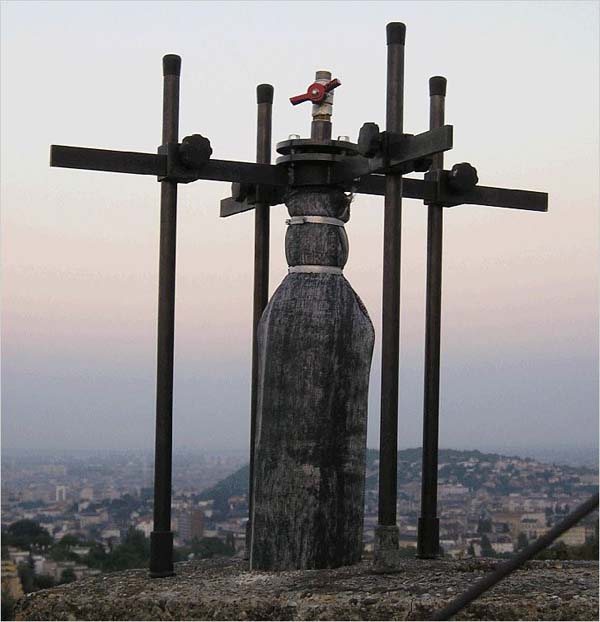

Polymer sleeve
The preliminary work before laying is no different from the previous types of "sleeve", you need to inspect the chimney and correct all the shortcomings. Further, the installation process with a polymer sleeve includes several main stages:
- A “sleeve” of appropriate length and size is placed inside the canal.
- The second stage includes the injection of compressed air into the interior.
- The third stage is similar to the second, however, instead of air, the sleeve is filled with steam.
Thus, in the first case, the sleeve is leveled, and with the help of steam, the seams and cracks are sealed, that is, the walls are ideally even and tight. Consider the fact that it is impossible to install such a chimney on your own; you need to use special equipment. So, choosing this method, remember that it is more expensive and requires not only special skills, but also equipment. However, all costs in the end - "fight back".

